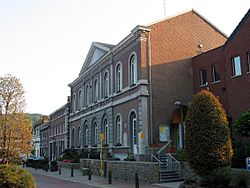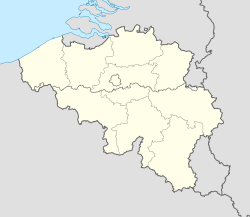Engis facts for kids
Quick facts for kids
Engis
Indji (Walloon)
|
||
|---|---|---|
 |
||
|
||
| Country | Belgium | |
| Community | French Community | |
| Region | Wallonia | |
| Province | Liège | |
| Arrondissement | Huy | |
| Area | ||
| • Total | 27.74 km2 (10.71 sq mi) | |
| Population
(2018-01-01)Lua error in Module:Wd at line 1575: attempt to index field 'wikibase' (a nil value).
|
||
| • Total | Lua error in Module:Wd at line 1,575: attempt to index field 'wikibase' (a nil value). | |
| Postal codes |
4480
|
|
| Area codes | 04, 085 | |
| Website | www.engis.be | |
Engis (pronounced ahn-zhee) is a town in Wallonia, a region in Belgium. It is located in the province of Liège.
As of January 1, 2006, Engis had a population of 5,686 people. The town covers an area of 27.74 square kilometers. This means there were about 205 people living in each square kilometer. By 2022, the population grew to about 6,269 people.
The municipality of Engis includes a few smaller areas. These are called districts. They are Clermont-sous-Huy, Engis itself, and Hermalle-sous-Huy.
A Big Discovery: The First Neanderthal
In 1829, something very important was found in Engis. A scientist named Philippe-Charles Schmerling discovered a skull. It belonged to a young child. This skull was later identified as the very first Neanderthal ever found!
This discovery happened long before another famous Neanderthal find in Germany in 1856. However, people didn't realize how important the Engis skull was until 1936. It showed that Neanderthals lived in this area a very long time ago.
Understanding Air Quality: A Historical Event
In late 1930 and early 1931, a serious event happened in the Meuse valley, especially around Engis. Many people experienced breathing problems. Sadly, some people also became very ill.
A special group was set up by the Belgian government to find out why this happened. They discovered that the air quality was very poor. This was due to gases from many factories in the valley. Also, furnaces used by people added to the problem.
Unusual weather conditions made the situation worse. The valley's shape also trapped the air. The main harmful gases were sulfur dioxide and possibly fluorine. This event taught people important lessons about air pollution and its effects on health.
See also
 In Spanish: Engis para niños
In Spanish: Engis para niños



